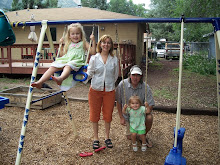Or another title for this post is
double digging. That is exactly what we accomplished this past weekend. After expanding the garden, we prepped a new vegetable bed. Paul and I have found that double digging promotes root expansion. In past years, we double dug one garden and simply tilled the other garden. The garden that we double dug produced healthier plants with greater resistance to pests as well as provided a greater yield in the end. The reason you double dig in Flagstaff is that the subsoil is usually compacted into chunks of dry soil, looking much like rock. By digging out a foot of your soil and then tilling the next 6-12 inches, you begin to break up the compression. Also you add nutrients into the soil during the double digging process.
So here are the steps:

1. If you have any healthy top soil, dig the first 1-3 inches of the top soil onto a tarp. The top soil contains most of microorganisms, fungus, and micronutrients that nourish your plants. This is why removing this top layer is important. Keep in mind that virgin ground in Flagstaff may have an inch or less of top soil. The top soil is fairly dark compared to the subsoil underneath. Past the dark layer is the subsoil which is slightly lighter in color and most likely more compacted. You will be shoveling the top soil back onto your garden in the final stages of the double digging process.

2. Once you have removed the top soil, dig a trench that is approximately 12 inches deep. Shovel the dirt onto the side of the garden, but try to avoid mixing it with the topsoil. Later in the process, you will be shoveling the subsoil and then topsoil back into the trench.

3. With a pitchfork, till the subsoil about 6-12 inches. This breaks up the hard compressed subsoil and gives room for roots to expand. NOTE: We chose to till by hand instead of using a rototiller. We believe that tilling by a pitchfork preserves the integrity of the soil without destroying earth worms and other important soil properties. However, this approach is not scientifically proven.

4. After you tilled the under layer, add a layer of compost or fertilizer to add nitrogen and other important nutrients to the under layer. We used alpaca dung combined with alfalfa at this stage. The alfalfa will compost underground. Some people do not like using alfalfa because, if there are any seeds, they will sprout as seedlings. We simply weed the alfalfa plants out when they begin to surface.
5. Next shovel the subsoil back into the trench.
6. Now spread the top soil onto the top of the bed.
7. Add important nutrients onto the top soil. We added our own homegrown compost, Earth Magic (which contains mycorrhizae, or fungus root), Protein Crumbles (which feeds the mycorrhizae). See references in my
Poor Man's Fertilizer post. Use a ground rake to mix the nutrients into the top soil. Saturate the garden with water.
 Paul made this compost tumbler out of a rain barrel.
Paul made this compost tumbler out of a rain barrel. 8. It is ideal to let the garden sit up to a week before you plant. We added hay as a mulch to prevent the top soil from drying out. We will remove the hay when we are ready to plant.
Double digging is an arduous process, but it is worth every tear, ache, and blister.













